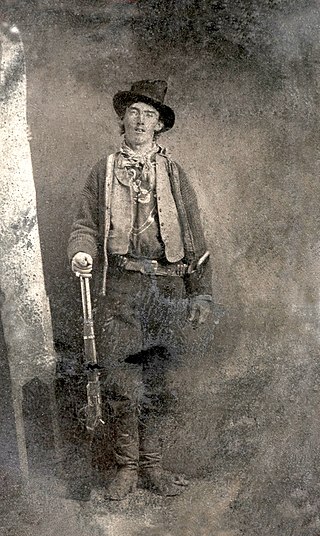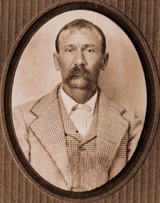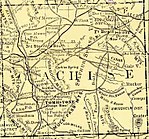
The Lincoln County War was an Old West conflict between rival factions which began in 1878 in Lincoln County, New Mexico Territory, the predecessor of the state of New Mexico, and continued until 1881. The feud became famous because of the participation of William H. Bonney. Other notable participants included Sheriff William J. Brady, cattle rancher John Chisum, lawyer and businessmen Alexander McSween, James Dolan and Lawrence Murphy.
George Scarborough was a cowboy and lawman who lived during the time of the Wild West. He is best known for having killed outlaw John Selman, killer of John Wesley Hardin, and for his partnership with lawman Jeff Milton, with the pair bringing down several outlaws during their time together.

William Brocius, better known as Curly Bill Brocius, was an American gunman, rustler and an outlaw Cowboy in the Cochise County area of the Arizona Territory during the late 1870s and early 1880s. His name is likely an alias or nickname, and some evidence links him to another outlaw named William "Curly Bill" Bresnaham, who was convicted of an 1878 attempted robbery and murder in El Paso, Texas.

Thomas Edward Ketchum was an American cowboy who later became an outlaw. He was executed in 1901 for attempted train robbery. The execution by hanging was botched; he was decapitated because the executioner used a rope that was too long.

The Earp Vendetta Ride was a deadly search by a federal posse led by Deputy U.S. Marshal Wyatt Earp for a loose confederation of outlaw "Cowboys" they believed had ambushed his brothers Virgil and Morgan Earp, maiming the former and killing the latter. The two Earp brothers had been attacked in retaliation for the deaths of three Cowboys in the Gunfight at the O.K. Corral on October 26, 1881. From March 20 to April 15, 1882, the federal posse searched southeast Cochise County, Arizona Territory for the men they believed were responsible for the attacks on Virgil and Morgan. Several suspects had been identified and were charged, but were soon released by the court, owing in some cases to legal technicalities and in others to the strength of alibis provided by Cowboy confederates. Wyatt hoped that the legal system would bring the Cowboys to justice, but after suspects in both ambushes were freed, Wyatt resolved to take matters into his own hands.

Josiah Gordon "Doc" Scurlock was an American Old West figure, cowboy, and gunfighter. A founding member of the Regulators during the Lincoln County War in New Mexico, Scurlock rode alongside such men as Billy the Kid.

Contention City or Contention is a ghost mining town in Cochise County in the southeastern part of the U.S. state of Arizona. It was occupied from the early-1880s through the late-1880s in what was then known as the Arizona Territory. Only a few foundations now remain of this boomtown which was settled and abandoned with the rise and fall of silver mining in and around the area of Tombstone.

Jefferson Davis Milton was an Old West lawman and a son of Confederate Governor of Florida John Milton. He was the first officer appointed to the U.S. Immigration Service Border Patrol in 1924.
The Jesse Evans Gang, also known as The Boys, was a gang of rustlers and robbers led by outlaw and gunman Jesse Evans, which lasted from 1876 until 1880. The gang was formed after Evans broke with the John Kinney Gang. After breaking away, he brought along with him Billy Morton, Frank Baker, Tom Hill, Dolly Graham, George Davis, Jim McDaniels, Buffalo Bill Spawn, Bob Martin, Manuel "Indian" Segovia and Nicholas Provencio.

William Larkin Stiles, better known as Billy Stiles or William Larkin, was an American outlaw in the Old West who, with partner Burt Alvord, led a small gang of train robbers while serving as a deputy sheriff in Arizona Territory.
Charles "Pony Diehl" Ray was an Old West outlaw in the New Mexico Territory and Arizona Territory. He was accused by Wyatt Earp of having taken part in an attempt to kill his brother, Virgil Earp. Diehl was not tried due to a lack of evidence.
Jack Dunlop, also known as John Dunlop, Jess Dunlop, John Patterson, and most commonly Three Fingered Jack was an outlaw in the closing days of the Old West, best known for being a train robber. Whether he had just three fingers on one of his hands is not confirmed.

Black Jack Christian, aka 202, or Ed Williams, was an outlaw of the Old West. He was a leader of a group known as the High Fives, which operated mostly in New Mexico Territory.

Cochise County in southeastern Arizona was the scene of a number of violent conflicts in the 19th-century and early 20th-century American Old West, including between white settlers and Apache Indians, between opposing political and economic factions, and between outlaw gangs and local law enforcement. Cochise County was carved off in 1881 from the easternmost portion of Pima County during a formative period in the American Southwest. The era was characterized by rapidly growing boomtowns, the emergence of large-scale farming and ranching interests, lucrative mining operations, and the development of new technologies in railroading and telecommunications. Complicating the situation was staunch resistance to white settlement from local Native American groups, most notably during the Apache Wars, as well as Cochise County's location on the border with Mexico, which not only threatened international conflict but also presented opportunities for criminal smugglers and cattle rustlers.

The Battleground Gunfight, also known as the Battleground Shootout, was a gunfight between a posse of American lawmen and the Smith Gang. It was fought on October 8, 1901, within Arizona Territory's Fort Apache Indian Reservation, at a clearing in the forest known today as the "Battleground". Nine Arizona Rangers and deputies caught up with the cattle rustler Bill Smith and his gang. During a long exchange of gunfire that followed, Ranger Carlos Tafolla and Deputy Bill Maxwell were killed and one or two of the outlaws may have been wounded. In the end, the Smith Gang escaped the posse and fled into Mexico.

Feuds in the United States deals with the phenomena of historic blood feuding in the United States. These feuds have been numerous and some became quite vicious. Often, a conflict which may have started out as a rivalry between two individuals or families became further escalated into a clan-wide feud or a range war, involving dozens—or even hundreds—of participants. Below are listed some of the most notable blood feuds in United States history, most of which occurred in the Old West.

The Skeleton Canyon shootout was a gunfight on August 12, 1896, between members of the High Five Gang and a posse of American lawmen. Following a failed robbery on August 1 of the bank in Nogales, Arizona, the High Fives headed east and split up. The gang's leader, Black Jack Christian, and George Musgrave got away.

Augustine Chacon, nicknamed El Peludo, was a Mexican outlaw and folk hero active in the Arizona Territory and along the U.S.–Mexico border at the end of the 19th century and the early 20th century. Although a self-proclaimed badman, he was well-liked by many settlers, who treated him as a Robin Hood-like character rather than a typical criminal. According to Old West historian Marshall Trimble, Chacon was "one of the last of the hard-riding desperados who rode the hoot-owl trail in Arizona around the turn of the century." He was considered extremely dangerous, having killed about thirty people before being captured by Burton C. Mossman and hanged in 1902.

The Fairbank train robbery occurred on the night of February 15, 1900, when some bandits attempted to hold up a Wells Fargo express car at the town of Fairbank, Arizona. Although it was thwarted by Jeff Milton, who managed to kill "Three Fingered Jack" Dunlop in an exchange of gunfire, the train robbery was unique for being one of the few to have occurred in a public place and was also one of the last during the Old West period.

Bill Downing a.k.a. William F. Downing was a notorious outlaw during the Wild West era in Arizona. Downing had fled from the Texas Rangers posse who was after him when he came to Arizona. In Arizona, he was involved in the killing of William S. “Slim” Traynor and in various train robberies including the robbery of the Train Depot in the town of Cochise. Downing was so unpopular that even members of his gang couldn't stand him.
















